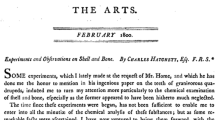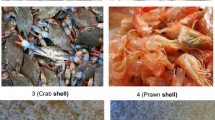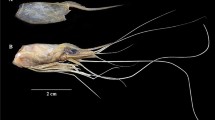Abstract
The chemical composition and thermal behaviour of crab, shrimp and lobster shells were studied. The lobster cephalothorax and its main parts also constitute important sources of both polymers. Their chitin and protein content are 20 and 40 %, respectively (dry base) while in these cases the proteins are less associated to the matrix than in the carapace. The chitin level in the chitinous concentrates isolated from different sources is over 80 % in all cases but the polymer characteristics change in dependence on the raw material.
Zusammenfassung
Es wurde die chemische Zusammensetzung und das thermische Verhalten von Krabben-, Garnelen- und Hummerpanzern untersucht. Der Hummer cephalothorax und auch seine Hauptteile bilden wichtige Quellen für beide Polymere. Der Chitin- und Proteingehalt beträgt 20 bzw. 40% (bezogen auf Trockensubstanz), während in diesem Falle die Proteine weniger an der Matrix assoziiert sind als im Panzer. Der Chitingehalt in aus verschiedenen Quellen gewonnenen Chitinauszügen liegt in allen Fällen über 80%, die Eigenschaften der Polymere schwanken jedoch in Abhängigkeit vom Ausgangsmaterial.
Similar content being viewed by others
References
M. Falk et al., Canadian J. of Chemistry, 44 (1966) 2269.
R. H. Hackman, Aust. J. Biol. Sci., 18 (1965) 935.
P. R. Austin et al., Science, 212 (1981) 749.
Ch. Brine, Comp. Biochem. Physiol., 69 B (1981) 283.
A. E. Murray and D. Hattis, Proc. of the First International Conference on Chitin/Chitosan, 1978, p. 30.
P. M. Perceval, Proc. of the First International Conference on Chitin/Chitosan, 1978, 45.
E. Peón, Estudio bioquímico de la langosta Panulirus argus. I.-Notas sobre investigaciones, No.3, C.I.P., 64 pp, 1961.
A.C.A.C., Official Methods of Analysis. 10th ed. Association of Official Agricultural Chemists, 1965.
L. Erdey, Bevezetés a kémiai analizisbe. Tankönyvkiadó Budapest, 1951, 73.
I. Garcia Alonso and D. Oviedo Vega, Thermoanalytical studies on lobster shell. II. Quantitative analysis. (not published).
I. Garcia Alonso et al., J. Therm. Anal., 28, (1983) 189.
I. Garcia Alonso, et al., Métodos para el aprovechamiento del desecho de la langosta común, ONIITEM, 4 A23J-1/04, Pat. No. 35844, 29 pp., 1983.
I. Garcia Alonso, J. Therm. Anal., 27 (1983) 257.
M. Bihari-Varga, Acta Biochim. et Biophys. Acad. Sci. Hung., 6 (3) (1971) 265.
D. Oviedo Vega and col., Interacctión quitina-proteina en el exoesqueleto branquial de la langosta (not published).
Author information
Authors and Affiliations
Rights and permissions
About this article
Cite this article
Alonso, I.G., Vega, D.O. Characterization of the main sources of chitin in cuba. Journal of Thermal Analysis 36, 891–899 (1990). https://doi.org/10.1007/BF01904625
Received:
Revised:
Issue Date:
DOI: https://doi.org/10.1007/BF01904625




